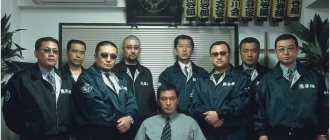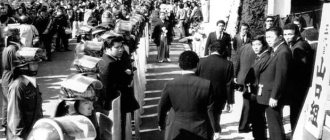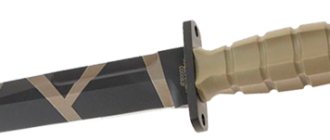Harsh secrets of Yakuza tattoos
The Japanese tattoo tradition is considered one of the oldest and most influential. And she's incredibly popular. A killer cocktail of elegant style, tart taste of exclusivity and renunciation of the life of well-behaved laymen has made the Japanese tattoo an art within an art. We, foreign gaijin, can only gaze in fascination at its intricate plots, trying to copy the works of the masters of the old school. But the Japanese style was glorified not by inspired masters, but by cruel criminals—the yakuza.
Where ink was first spilled
In one form or another, the culture of decorating the body with tattoos - or related scarification (scarring) - is found all over the world. It is so ancient that it is simply impossible to find out who and in what burst of inspiration first came up with the idea of injecting sooty ink into the skin. The best source of knowledge, which we can only rely on, is the myths and legends that have been preserved since time immemorial. And since there was no trace of writing at that time, it is not difficult to guess that over the inhumanly long centuries this information has undergone such changes that one could just as easily create a new legend - and it would turn out to be no less true.
The origins of the Japanese tattooing tradition are usually associated with the semi-mythical Ainu people. Presumably, the Ainu moved to the Japanese islands from Siberia and the lower reaches of the Amur region during the decline of the Upper Paleolithic approximately 15 thousand years ago. Having settled across all the islands from Ryukyu to Hokkaido, they founded the Jomon culture, famous for its mysterious dogu figurines. The complex patterns covering the bodies of the “Jomon Venus” are considered the first documentary evidence that the ancient population of Japan invented a certain method of applying permanent patterns to the skin and willingly used it. This assumption is partly confirmed by the text of a later Chinese treatise, “The Legend of the Wa People from the History of the State of Wei” (“Weizhi Wozhen-zhuan”), dating back to 280-290 AD. e. In it, historian Chen Shou talks about the men of the country of Wa (as Japan was called during the Wei Dynasty), who abundantly decorated their faces and bodies with tattoos.
The most accurate idea of what the first Japanese tattoos were like is given by the Polynesian tradition, in particular the sacred ta-moko for the Maori people. Its peculiarity is that the design was applied not with the help of needles, but with a special “ear” chisel, which is why after healing, relief scars colored with pigment remained on the skin.
From privilege to stigma
Centuries passed. Towards the end of the Jomon period, the agrarian revolution broke out, and with it came the time of the legendary achievements of Yayoi. The first empire was born on the Eight Islands. The Japanese learned rice, bronze and iron. The people's attitude towards body designs was gradually revised.
According to legend, the first emperor of Japan, Jimmu, a descendant of the goddess Amaterasu herself, wore such beautiful tattoos that he won the heart of Queen Senoyataru, who composed a poem in their honor. Tattooing became the exclusive privilege of emperors and remained so until 500 AD. e., when this expensive pleasure finally became available to a wide circle of wealthy gentlemen. Not only the nobility, but also officials and merchants, fed up with the abundant life, desired to at least in some way become like the august persons. And they learned the hard way that royal life is not so sweet. At that time, tattoos were applied with sharp bamboo sticks. The process was very painful, and most importantly, long. The execution lasted for hours.
Read: “The Evil Eye” – it’s quite possible to kill with a glance
By the 7th century, Japanese views on tattoos had once again undergone radical changes. Maybe the old fashion has become obsolete, or maybe it’s all due to the penetration of Buddhism into the Land of the Root of the Sun (this is how the name “Japan” is literally translated from Japanese), but by the end of the Yamato era, tattoos became a symbol of the underworld. A shameful stigma that cannot be washed away. Evidence of punishment by tattooing is found in the Records of Ancient Affairs (Kojiki) of 712 and the Annals of Japan (Nihon Shoki), written in 720. By irezumi (literally, “to introduce ink”) - permanent marks on the bodies of criminal elements of the past - it was possible to judge what the crime was and in which prison the scoundrel was serving his sentence. Actually, even today little has changed in this regard. Do you feel the rain blowing in the silver apricot grove? I mean, what is autumn like in the camps?
Until the Tokugawa shogunate came to power, a Japanese with a tattoo was considered an outcast. His family turned away from him, his path to decent society was barred. To survive, the marked unfortunate was forced to either take on the dirtiest and hardest work, or continue to rob.
Old school
For almost a thousand years, the tradition of Japanese tattooing by a poor relative huddled on the margins of cultural life. However, tradition is a strong word. The tattoos of that time had no more artistic value than a modern criminal tattoo. In order to somehow disguise the mistakes of the past, the inmates “filled” the tattoos they received in prison with more meaningful drawings. For example, a simple line in the elbow area, the distinctive mark of a thief, could turn into a snake, by the bends of which one could judge the “merits” of its owner. Gradually, such artisanal creativity grew into a complex system of symbols and “concepts” (yes, exactly in the sense you were thinking about), waiting for the right moment to appear in all its ambiguous glory.
A new life for Japanese tattooing began with the advent of the Edo period. Before the reign of the shogunate, Japanese culture experienced a period of romanticism - the flowering of sensual literature and elegant painting. With the seizure of power by the Tokugawa clan, culture began to rapidly reshape itself in accordance with the postulates of the treatise on samurai honor "Hagakure", which proclaimed the only correct principle of life for a noble husband - live as if you were already dead. Abroad, it is better known as bushido - the code of the samurai. That's all love is. But the nature of the people quickly took its toll.
Deep in their souls, not every samurai was ready to meekly swallow the dry ration of self-sacrifice, military asceticism, chastity and unquestioning love for the overlord. Samurai are addicted to tattooing. Favorite motifs were chrysanthemum and cherry blossoms - symbols of the beauty of life, which can end at any moment. Samurai morality, stingy with delights, brought society a gift in the form of a strict ban on nudity, which greatly interfered with the work of geishas and courtesans. But the cunning foxes quickly found a way out: they covered their own bodies with tattoos. Thematic compositions and ornate patterns created the illusion of clothing on the body, making the beauty only more seductive in the eyes of clients. The popularity of artistic tattooing also grew thanks to kabuki theater actors, who used drawings on the body to achieve the utmost degree of dramatic intensity.
Read: Eyes instead of a lighter - the phenomenon of pyrokenesis
Between 1603 and 1868, the Japanese tattoo tradition reached aesthetic perfection. The profession of tattoo artist began to enjoy special respect. Irezumi, applied with special bamboo tebori sticks, chisels and artistic templates, became more complex and colorful. Finally, a unique style and subject matter were formed, making the Japanese school of tattooing one of the most recognizable and popular. The old masters were either artists themselves, or worked in tandem with engravers - one drew a sketch, and the other applied it to the body. Things got so busy that for the most popular subjects, carvers made special matrices from which sketches were printed. The canons of tattooing, nurtured during the Edo period, are still carefully preserved by masters. But the main heirs to the traditions of classical Japanese tattooing were the notorious yakuza.
Hiding in plain sight
A person who, until now, had never even heard of the yakuza, can only be congratulated on his safe arrival in the real world. After all, the Japanese mafia is one of the most powerful criminal conglomerates in history.
In the 17th century, the nascent yakuza was represented by two independent groups - Bakuto and Tekiya. The first included ronin (samurai without a master) and yesterday’s vassals who lost their property at the behest of the overlord daimyo or shogun. In the second - petty extortionists, thieves, swindlers and robbers from among the completely degraded ronins. Gradually, the prospect of a boring life under a strong-willed leadership lured into the shadow of gangs of impoverished peasants, vagabonds and marginalized people who were crawling into the light of day from the murky sediments of the social bottom. The samurai background of the gang leaders eventually made the Yakuza a fearsome force.
The Yakuza is unique. It is fundamentally different from the no less famous Italian-American mafia, which grew by leaps and bounds in the Great Depression. Relations within the yakuza clans were built according to the principles of bushido, nurtured in the harsh centuries of the shogunate. Unquestioning obedience to the boss, strict adherence to the rules and inevitable punishment for misconduct became the key to the longevity and terrifying success of the Japanese mafia. Its internal hierarchy, like that of the Western mafia, is based on the concept of family, but the backbone of the structure is not consanguineous ties, but relationships of a different kind. By joining a group, newcomers become adopted “sons” of the head of the oyabun clan and “brothers” to each other. At the same time, the Japanese mafia does not even try to hide the composition and number of members of the organization, the names of the bosses and the addresses of the headquarters. Most groups have official emblems - something between the clan symbols of samurai clans and a trademark.
Read: Why don't we remember dreams?
Today, the yakuza is so deeply woven into the economic, political and social life of Japan that if you take the mafia out of them, the country will fall apart, like a galaxy without dark matter.
Perhaps the most characteristic distinctive feature of gokudo, members of yakuza groups (if you do not take into account inhuman cruelty and cold-bloodedness), were their famous tattoos, covering almost the entire body.
New Yakuza Mythology
To turn yourself into a living canvas, you will have to visit the tattoo artist every week for several years. Agree, the test is not for the faint-hearted. It is not for nothing that tattooing in the traditional way (with tebori sticks) has traditionally served not only as a rite of passage, but also as a test. If someone aiming for the Yakuza bursts into tears like a girl from some kind of needles, he’s worth a broken yen.
Even if you don’t look closely at the style and plot of the image, a Japanese tattoo can be easily recognized by its shape. It can cover the entire body in a single composition, take the form of an “unwrapped haori” (leaving a narrow strip of clear skin on the chest) or cover an entire arm or leg, like a sleeve or pant leg. But even though a tattoo can occupy up to 80% of the body, it never extends to the neck, hands or feet. Drawings on the body can easily be hidden under clothes. This feature has remained from those times when tattoos were still the lot of criminals.
There is an opinion that even behind the most benign symbol one can find a vulgar selfish motive. In the case of yakuza tattoos, you don’t even have to dig deep. Classic tattoo images, developed by masters of the old school, having fallen into the millstones of the Yakuza worldview, gradually lost their former philosophical meaning, acquiring very specific meanings. Therefore, just by the patterns on the body of boryokudan members, one can say a lot about the status and personality of their wearer.
For example, the image of the boy Kintaro fighting a giant koi carp, once a symbol of masculinity and bravery, suggests that the yakuza are masters of hand-to-hand combat. The wrathful deity Fudo Myo, cutting through illusions with a sword and awakening righteous thoughts in the infidels, began to adorn the bodies of smugglers and drug dealers. Members of the group responsible for the gambling business get tattoos with the image of the Fo dog, a Chinese symbol of valor and energy. The image of the Oni demon or Hanya mask, which was once a symbol of determination and a talisman for its wearer, has become the mark of ordinary Yakuza - militants, collectors and murderers. Peonies and severed heads decorate the bodies of those gokudos who are unquestioningly ready to give their lives for the boss. The clan leaders themselves wear tattoos with images of tigers and dragons - symbols of unlimited power.
But this does not mean at all that, through the efforts of the current yakuza, the traditional Japanese tattoo has lost its meaning and artistic value. The Japanese deeply respect traditions and carefully preserve their sacred meanings. A thin dotted line of ink dots on the skin like an inextricable web connected the past and the present through the centuries. And so what if graceful beauty and barbaric savagery are intertwined in it...











